Are you in need of a hot pepper flakes substitute for your next spicy dish? Look no further! In this article, we will explore the top alternatives to hot pepper flakes that will enhance the heat and flavor of your meals. Whether you’re out of red pepper flakes or simply looking to try something new, we’ve got you covered. Let’s dive in and discover the perfect substitute for your next culinary adventure!
Table of Contents
Key Takeaways:
- There are several substitutes for hot pepper flakes that can add heat and flavor to your dishes.
- Options such as ground cayenne pepper, chili powder, crushed red chili peppers, and paprika can be used as alternatives.
- Experiment with different combinations and adjust the quantities to achieve the desired taste and spiciness.
- Consider the consistency and texture of the substitute when using it in recipes.
- Enjoy spicy dishes even when you’re out of hot pepper flakes by exploring these substitutes.
What are Red Pepper Flakes
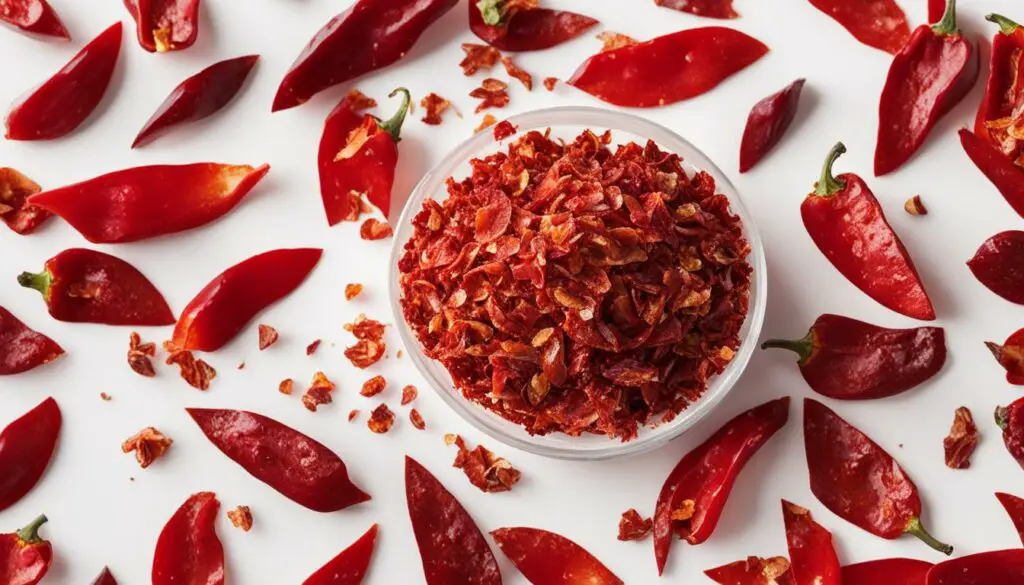
Red pepper flakes, also known as red chili flakes, are a popular spice made from dried and crushed red chili peppers. They have a vibrant flavor and add a spicy kick to various dishes. With a Scoville Heat Unit (SHU) ranging from 15,000 to 30,000, they provide a convenient way to customize the level of heat in your recipes. Red pepper flakes are commonly used in pizzas, pasta sauces, stir-fries, and marinades.
These flakes are made by harvesting ripe red chili peppers and drying them until they become brittle. The dried peppers are then crushed or ground into coarse flakes, typically using a mortar and pestle or a spice grinder. The intensity of the resulting flakes depends on the type of chili peppers used and whether the seeds and membranes are included during the grinding process. Some commercial varieties may also include additional seasonings or additives to enhance flavor or control heat levels.
Red pepper flakes have a distinct taste characterized by a spicy, hot, and pungent flavor. They deliver a fiery heat that can range from moderate to intense, depending on the variety and quantity used. Alongside the heat, red pepper flakes possess a slightly smoky and earthy undertone. The flavor profile of red pepper flakes can vary slightly based on the specific chili peppers used in their preparation.
Overall, red pepper flakes are a versatile spice that adds a punch of heat and flavor to a wide range of dishes. Whether you’re sprinkling them on a pizza or stirring them into a sauce, red pepper flakes are a must-have ingredient for spice lovers.
What do Red Pepper Flakes Taste Like
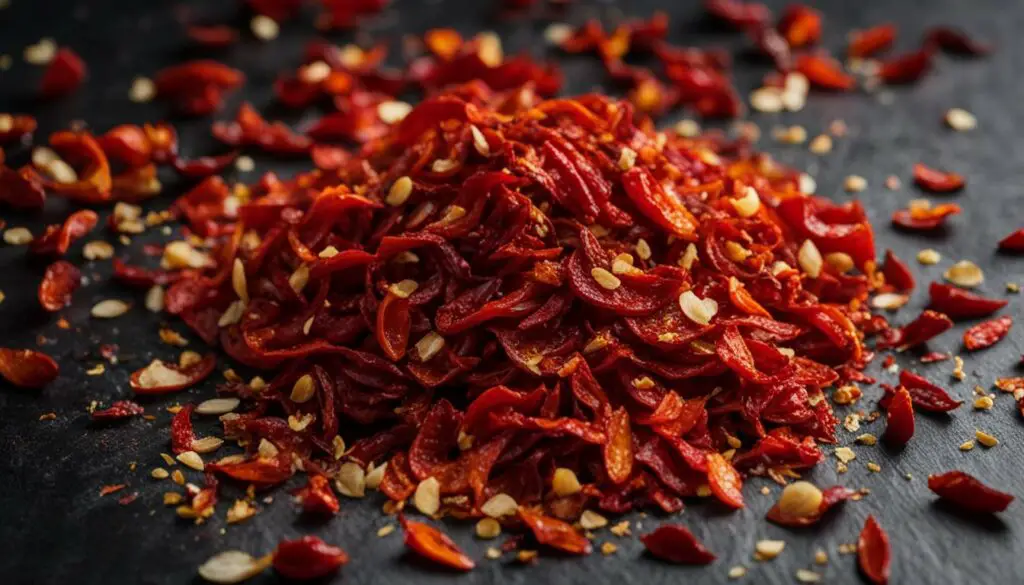
Red pepper flakes have a distinct taste characterized by a spicy, hot, and pungent flavor. They deliver a fiery heat that can range from moderate to intense, depending on the variety and quantity used. Alongside the heat, red pepper flakes possess a slightly smoky and earthy undertone. The flavor profile of red pepper flakes can vary slightly based on the specific chili peppers used in their preparation.
“Red pepper flakes have a distinct, spicy flavor with a fiery kick. They add a pungent and slightly smoky taste to your favorite dishes.”
If you’re a fan of spicy food, you’ll love the intense heat that red pepper flakes bring to your meals. They can instantly elevate the flavor of any dish with their bold and fiery taste. Whether you’re sprinkling them on a pizza, adding them to a pasta sauce, or tossing them in a stir-fry, red pepper flakes are sure to pack a punch.
Spice up your dishes with red pepper flakes
When it comes to adding a touch of heat to your recipes, red pepper flakes are a go-to spice. Their spicy flavor pairs well with a variety of cuisines and ingredients, making them a versatile pantry staple. Whether you prefer a subtle kick or a fiery explosion of flavor, red pepper flakes can be adjusted to suit your taste. So go ahead, experiment with different dishes and discover the perfect balance of heat and flavor that red pepper flakes have to offer.
How are Red Pepper Flakes Made
Red pepper flakes are made through a simple yet meticulous process. It all starts with harvesting ripe red chili peppers, which are then carefully dried until they become brittle. This drying process can be done naturally by hanging the peppers in a well-ventilated area or by using a dehydrator. Once the peppers are completely dry, they are ready to be transformed into flakes.
The next step is the crushing process, where the dried peppers are crushed or ground into coarse flakes. This can be done using a mortar and pestle or a spice grinder. The intensity of the resulting flakes can be influenced by the type of chili peppers used and whether the seeds and membranes are included during the grinding process. It’s worth noting that some commercial varieties of red pepper flakes may also contain additional seasonings or additives to enhance flavor or control heat levels.
The process of making red pepper flakes ensures that they retain their vibrant flavor and fiery heat. With their intense spiciness and distinct taste, these flakes provide a convenient way to add a kick to various dishes.
| Step | Description |
|---|---|
| 1 | Harvest ripe red chili peppers |
| 2 | Dry the peppers until brittle |
| 3 | Crush or grind the dried peppers into coarse flakes |
| 4 | Optional: Include seeds and membranes for extra heat |
| 5 | Pack the flakes, possibly with additional seasonings or additives |
Recipes with Red Pepper Flakes
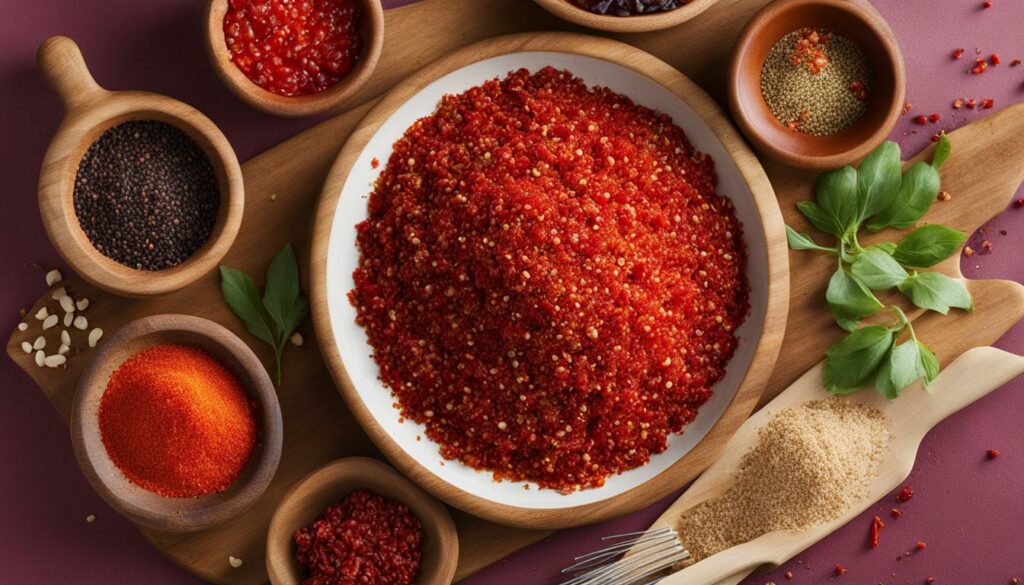
Red pepper flakes are a fantastic addition to various recipes, adding a delightful spicy kick. Whether you’re a fan of bold and fiery flavors or just want to add a little heat to your dishes, these recipes with red pepper flakes are perfect for you. Get ready to tantalize your taste buds and enjoy some spicy and flavorful creations!
1. Cheesy White Bean and Tomato Skillet: This easy and delicious one-pan meal combines white beans, tomatoes, spinach, and a generous sprinkle of red pepper flakes for a satisfyingly spicy and cheesy dish.
2. Creamy Pumpkin and Sausage Pasta Bake: This comforting pasta bake features creamy pumpkin sauce, sausage, and a touch of red pepper flakes to elevate the flavors and add a hint of spiciness.
3. Spicy Beef and Chorizo Chili: Warm up on a chilly day with this hearty and spicy chili packed with beef, chorizo, beans, and a good dose of red pepper flakes to amp up the heat.
4. One Pot Creamy Leek Pasta: Indulge in a creamy and flavorful pasta dish with caramelized leeks, garlic, cream, and a sprinkle of red pepper flakes for a subtle kick that complements the dish perfectly.
5. Spicy Jalapeño Turkey Burgers: Add some heat to your burger game with these juicy turkey burgers infused with chopped jalapeños and a touch of red pepper flakes for an extra zing.
These are just a few examples of the many recipes that can be enhanced with red pepper flakes. Feel free to experiment and adjust the amount of red pepper flakes based on your preference for spiciness. Remember to taste test along the way to ensure the perfect balance of flavors in your spicy creations!
Best Substitutes for Red Pepper Flakes (Top 10)
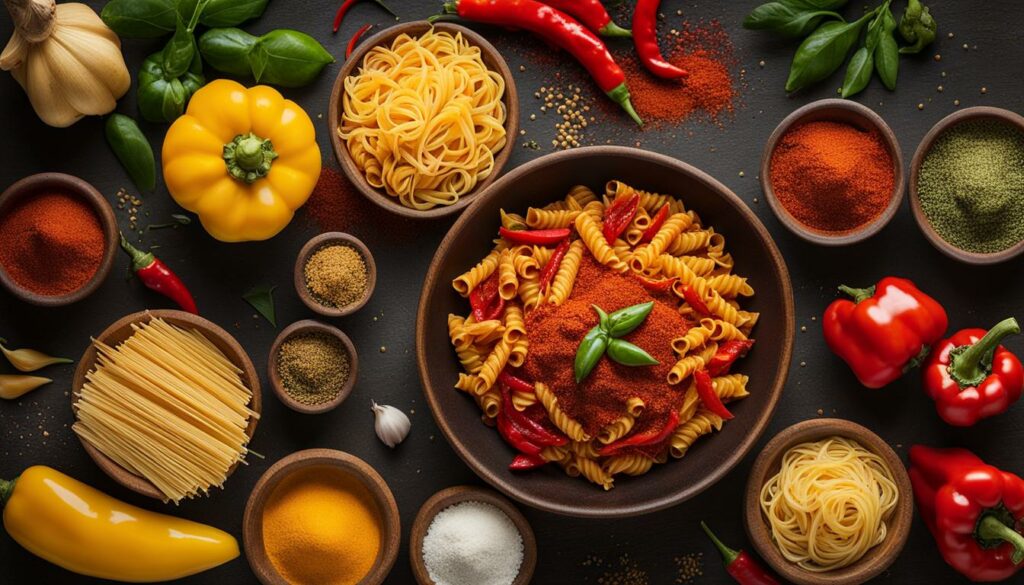
If you’re looking for a substitute for red pepper flakes, here are the top 10 options:
- Ground Cayenne Pepper: Offers a similar level of heat to red pepper flakes, use in a 1/2 teaspoon to 1 teaspoon ratio.
- Chili Powder: Provides a balanced heat and flavor profile, start with a 2:1 ratio.
- Crushed Red Chili Peppers: Closely resembles red pepper flakes in spiciness and flavor, use in the same amount as red pepper flakes.
- Paprika: Offers a milder, smoky flavor without overwhelming heat, use a 1:4 ratio compared to red pepper flakes.
- Chipotle Powder: Adds a smoky flavor and moderate heat, use in a 1:1 ratio or adjust to taste.
- Aleppo Pepper: Has a fruity taste with moderate heat, use in a 1:1 ratio or adjust to taste.
- Guajillo Powder: Provides medium-high spiciness with earthy notes, use in a 1:1 ratio or adjust to taste.
- Fish Pepper: Known for its smoky flavor and high heat, use sparingly for an extra-spicy kick.
- Sandia Chiles: Packed with vitamins and used in kimchi, a healthy alternative with a similar taste profile.
- Paprika (Hot or Sweet): Offers some heat and smokiness, adjust the amount to achieve the desired flavor.
These substitutes can be easily found in most grocery stores or online, and they provide a range of flavor profiles and heat levels to suit your preferences. Whether you’re looking for a milder option like paprika or a spicier alternative like crushed red chili peppers, these substitutes offer versatility in your cooking.
Experiment with these substitutes in your favorite recipes to find the perfect flavor and heat combination. Remember to start with small amounts and adjust to taste, as the intensity of the substitutes may vary. Enjoy exploring the world of alternatives to red pepper flakes and discover new ways to add spice to your dishes!
Homemade Red Pepper Flakes
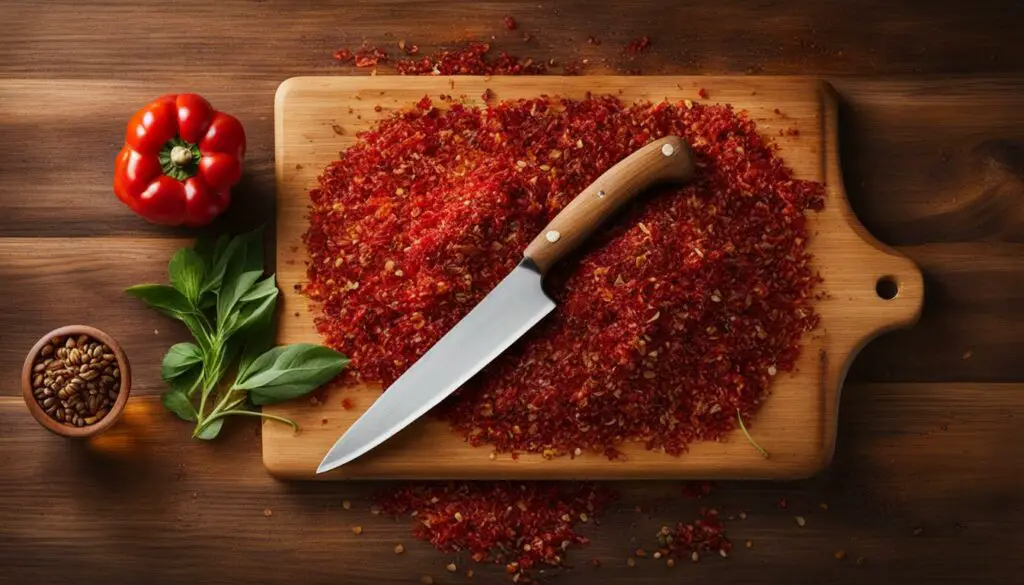
If you can’t find red pepper flakes or simply prefer to make your own, it’s surprisingly easy to create homemade red pepper flakes. Not only does this give you control over the heat level and flavor, but it can also be a fun and rewarding process. Here’s a simple DIY recipe to make your own red pepper flakes:
1. Choose and Prepare the Chili Peppers: Select ripe red chili peppers of your choice, whether it’s fiery habaneros or milder jalapenos. Wash the peppers thoroughly to remove any dirt or debris, and pat them dry.
2. Drying the Peppers: Hang the peppers in a well-ventilated area, away from direct sunlight, or use a food dehydrator. Allow the peppers to dry for several weeks until they become completely dry and brittle. Alternatively, you can also dry them in an oven set to a low temperature.
3. Crushing the Peppers: Once the peppers are dry, you can crush them into coarse flakes using a mortar and pestle or a spice grinder. Adjust the coarseness to your liking based on whether you prefer finer or chunkier flakes.
4. Sieving and Storing: After crushing the peppers, pass the flakes through a fine-mesh sieve to remove any remaining seeds or particles. Transfer the homemade red pepper flakes to an airtight container, such as a glass jar or a ziplock bag, and store them in a cool, dark place to maintain their flavor and potency.
By making your own red pepper flakes, you can enjoy the satisfaction of creating a homemade spice that adds a fiery kick to your favorite dishes. The process is not only easy but also allows you to experiment with different chili pepper varieties to customize the heat level and flavor to suit your preferences.
Tips for Using Homemade Red Pepper Flakes
Now that you have your own homemade red pepper flakes, here are some tips for using them in your recipes:
- Start with small amounts and adjust to taste. Homemade flakes may have a more intense flavor than store-bought ones.
- If you prefer less spiciness, you can remove the seeds and membranes from the chili peppers before drying and crushing them.
- Add the homemade flakes towards the end of the cooking process to preserve their flavor and heat.
- Store the homemade red pepper flakes in an airtight container in a cool, dark place to maintain their freshness and potency for longer.
With your own homemade red pepper flakes on hand, you can elevate the heat and flavor of a wide range of dishes, from pizzas and pastas to stir-fries and marinades. Get creative and experiment with different recipes to discover the perfect balance of spice that suits your palate.
Using Red Pepper Flakes Substitutes in Recipes
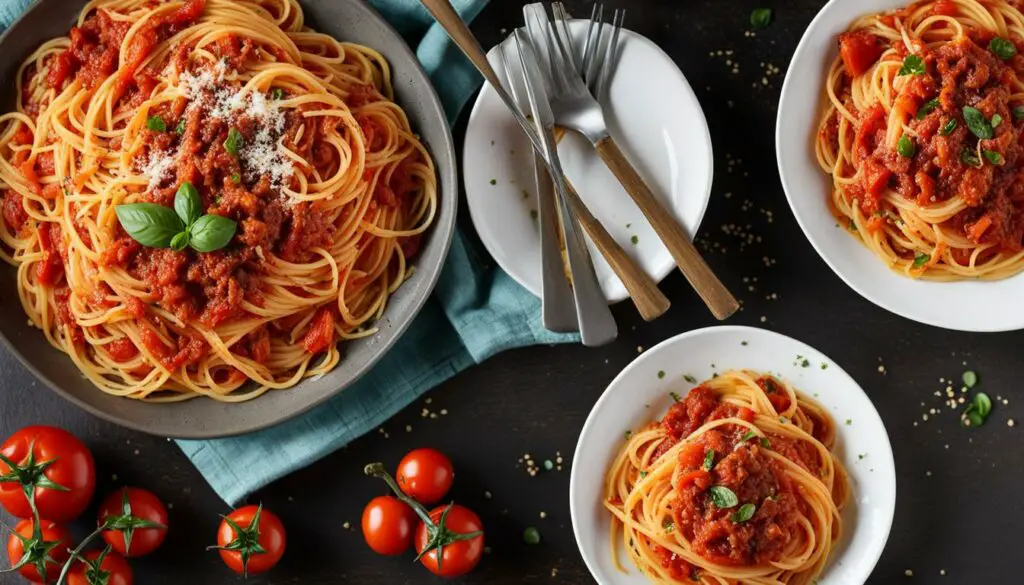
When it comes to using substitutes for red pepper flakes in your recipes, there are a few key considerations to keep in mind. First and foremost, start with small amounts and adjust to taste, as the intensity of the substitutes may vary. Since each substitute has its own unique flavor profile, it’s essential to taste test before serving the dish to ensure the desired level of spiciness and flavor.
Another factor to consider is the consistency of the substitute. Red pepper flakes have a coarse texture, so if you’re using a finer substitute like ground cayenne pepper or chili powder, it’s important to be mindful of the difference in texture. You can balance out the flavors by adding additional spices or herbs that complement the substitute, allowing you to customize the taste of your dish to perfection.
Experimentation is key when it comes to cooking with alternative spices. Don’t be afraid to get creative and try different combinations to find the perfect substitute for your recipe. Whether you’re using crushed red chili peppers, paprika, or other options, each substitute offers its own unique twist to your dish, allowing you to create exciting and flavorful meals.
So, the next time you find yourself out of red pepper flakes, don’t worry. With a little experimentation and an open mind, you can still spice up your dishes and enjoy the heat and flavor you love. Cooking with alternative spices is all about exploring new flavors and finding what works best for you. Happy cooking!
Table: Substitutes for Red Pepper Flakes
| Substitute | Usage Ratio | Flavor Profile | Heat Level |
|---|---|---|---|
| Ground Cayenne Pepper | 1/2 teaspoon to 1 teaspoon | Spicy, earthy | High |
| Chili Powder | 2:1 ratio | Balanced, smoky | Moderate |
| Crushed Red Chili Peppers | Same amount as red pepper flakes | Spicy, pungent | High |
| Paprika | 1:4 ratio compared to red pepper flakes | Mild, smoky | Low |
| Chipotle Powder | 1:1 ratio or adjust to taste | Smoky, moderate heat | Moderate |
Substituting Gochugaru with Red Pepper Flakes
Gochugaru is a popular Korean spice made from dried and ground red chili peppers. While it has a unique flavor and heat profile, you can still substitute gochugaru with red pepper flakes in a pinch. Although the flavor and heat will be different, red pepper flakes can add a spicy kick to your recipe. To substitute gochugaru with red pepper flakes, adjust the amount based on your preference for heat and flavor. Start with a small amount and gradually increase to achieve the desired spiciness.
If you don’t have gochugaru and need to replace it with red pepper flakes, keep in mind that the texture of the flakes may be slightly different. Gochugaru has a slightly coarse texture, while red pepper flakes are smaller and finer. Despite this difference, you can still use red pepper flakes as a substitute and enjoy a similar level of spiciness in your dishes. Just remember to adjust the quantity and taste as you go to find the right balance for your recipe.
It’s worth noting that if you’re specifically looking for the unique flavor of gochugaru, red pepper flakes may not provide the same taste. Gochugaru has a distinct fruity and slightly smoky flavor that sets it apart. However, if you’re simply looking to add some spiciness to your dish, red pepper flakes can work well as a substitute. Experiment with different quantities and combinations to find the right balance of heat and flavor for your recipe.
“While red pepper flakes can be used as a substitute for gochugaru in a pinch, keep in mind that the flavor and texture will be different. Red pepper flakes are smaller and finer, whereas gochugaru has a slightly coarse texture and unique fruity taste. Adjust the quantity of red pepper flakes based on your preference for heat and flavor, and remember to taste as you go to find the right balance.”
| Gochugaru Substitute | Heat Level | Flavor Profile |
|---|---|---|
| Ground Cayenne Pepper | High | Spicy, slightly bitter |
| Chili Powder | Moderate | Mild, slightly smoky |
| Aleppo Pepper | Moderate | Fruity, tangy |
| Guajillo Powder | Moderate | Earthy, slightly sweet |
| Fish Pepper | High | Smoky, citrusy |
| Sandia Chiles | Moderate | Robust, slightly fruity |
Substitutes for Gochugaru (Korean Chili Powder)
If you’re looking for alternatives to gochugaru, there are several options you can try. Each substitute offers a different flavor profile and heat level, allowing you to customize your dish to your liking. Here are some popular options:
1. Ground Cayenne Pepper
This spice provides a similar level of heat to gochugaru. Start by using it in a 1:1 ratio, and adjust to taste. Ground cayenne pepper adds a fiery kick to dishes and works well in recipes that call for gochugaru.
2. Chipotle Powder
Chipotle powder adds a smoky flavor and moderate heat to your dishes. Use it in a 1:1 ratio or adjust according to your preference. It pairs well with meats, soups, and stews, giving your recipe a rich and complex flavor.
3. Aleppo Pepper
Known for its fruity taste and moderate heat, Aleppo pepper can be used as a substitute for gochugaru. Use it in a 1:1 ratio to achieve a similar flavor profile. Aleppo pepper is popular in Middle Eastern and Mediterranean cuisines.
4. Guajillo Powder
If you enjoy earthy flavors with medium-high spiciness, guajillo powder is a great option. Use it in a 1:1 ratio or adjust to your liking. Guajillo powder adds depth to Mexican dishes like enchiladas, salsas, and mole sauces.
5. Fish Pepper
For those looking for an extra-spicy kick, fish pepper is a great substitute for gochugaru. Use it sparingly as it has a high heat level. Fish pepper is known for its smoky flavor and is commonly used in seafood dishes and hot sauces.
Experiment with these substitutes and adjust the quantities to achieve the desired taste and spiciness in your recipe. Each spice offers a unique flavor profile, allowing you to explore different culinary possibilities!
| Substitute | Flavor Profile | Heat Level | Usage Ratio |
|---|---|---|---|
| Ground Cayenne Pepper | Fiery and pungent | High | 1:1 |
| Chipotle Powder | Smoky and mild | Moderate | 1:1 |
| Aleppo Pepper | Fruity and mild | Moderate | 1:1 |
| Guajillo Powder | Earthy and medium spiciness | Medium-high | 1:1 |
| Fish Pepper | Smoky and very high spiciness | High | Sparingly |
Remember, each substitute has its own distinctive characteristics. Choose the one that best complements your recipe and enjoy the flavorsome journey of cooking with gochugaru alternatives!
Tips for Using Gochugaru Substitutes
When it comes to using substitutes for gochugaru, there are a few tips to keep in mind to ensure the best results in your dishes. Here are some helpful tips to guide you:
Start with Small Amounts
Since each substitute has its own unique flavor profile and heat level, it’s important to start with small amounts and gradually adjust to taste. This will allow you to find the perfect balance of spiciness and flavor for your recipe.
Consider Texture and Consistency
Keep in mind that the texture and consistency of the substitute may differ from gochugaru. Some substitutes may have a finer or coarser texture, so be aware of this when adding them to your recipe. If the texture matters for the final dish, choose a substitute that closely matches gochugaru in terms of texture.
Taste Test Before Serving
Before serving your dish, do a taste test to ensure the desired level of spiciness and flavor. Adjust the amount of substitute if necessary to achieve the perfect balance. Tasting beforehand allows you to make any necessary adjustments before presenting your dish to others.
By following these tips, you can confidently use gochugaru substitutes in your recipes. Remember to start with small amounts, consider the texture and consistency, and do a taste test before serving. With these substitutes, you can explore new flavors and spice up your dishes with delicious alternatives to gochugaru.
Table: Comparing Gochugaru Substitutes
| Substitute | Flavor | Heat Level | Texture |
|---|---|---|---|
| Ground Cayenne Pepper | Spicy and pungent | High | Finely ground |
| Chipotle Powder | Smoky and earthy | Moderate | Coarse |
| Aleppo Pepper | Fruity and tangy | Mild to medium | Coarse |
| Guajillo Powder | Earthy and slightly sweet | Moderate | Finely ground |
| Fish Pepper | Smoky and intense | High | Coarse |
Conclusion
In conclusion, if you’re looking for a hot pepper flakes substitute, there are plenty of alternatives to explore. Whether you prefer the fiery kick of ground cayenne pepper, the balanced heat of chili powder, the spiciness of crushed red chili peppers, or the smoky flavor of paprika, there is a perfect option for your spicy dishes. By experimenting with different combinations and adjusting the quantities to your taste, you can continue to enjoy flavorful meals even when you’re out of hot pepper flakes.
Discovering substitutes for hot pepper flakes opens up a world of possibilities in the kitchen. You can customize the level of heat and flavor to suit your preferences and create dishes that are uniquely yours. So the next time you find yourself without hot pepper flakes, don’t worry! With these alternatives at your disposal, you can still spice up your meals and satisfy your cravings.
Explore the wide range of substitutes available and let your culinary creativity shine. From ground cayenne pepper to paprika, there’s a substitute for every taste and recipe. Don’t be afraid to experiment and try new combinations. Who knows, you may even discover a new favorite spice that will become a staple in your kitchen. So go ahead, embrace the world of hot pepper flakes substitutes and elevate your dishes to new levels of flavor and spiciness!
FAQ
What are the best substitutes for hot pepper flakes?
The top substitutes for hot pepper flakes include ground cayenne pepper, chili powder, crushed red chili peppers, paprika, chipotle powder, Aleppo pepper, guajillo powder, fish pepper, sandia chiles, and hot or sweet paprika.
How are red pepper flakes made?
Red pepper flakes are made by harvesting ripe red chili peppers, drying them until they become brittle, and then crushing or grinding them into coarse flakes.
What do red pepper flakes taste like?
Red pepper flakes have a spicy, hot, and pungent flavor with a slightly smoky and earthy undertone.
What dishes can I use red pepper flakes in?
Red pepper flakes are commonly used in pizzas, pasta sauces, stir-fries, marinades, and a variety of other dishes.
Can I make homemade red pepper flakes?
Yes, you can make homemade red pepper flakes by drying and crushing ripe red chili peppers.
How do I use substitutes for red pepper flakes in recipes?
Start with small amounts and adjust to taste when using substitutes for red pepper flakes. Consider the consistency and texture of the substitute and balance flavors by adding additional spices or herbs.
Can I substitute red pepper flakes with gochugaru?
While red pepper flakes and gochugaru have different flavors and heat levels, you can substitute red pepper flakes for gochugaru in a pinch. Adjust the amount based on your preference for heat and flavor.
What are some alternatives to gochugaru?
Alternatives to gochugaru include ground cayenne pepper, chipotle powder, Aleppo pepper, guajillo powder, fish pepper, and sandia chiles.
How should I use gochugaru substitutes in recipes?
Start with small amounts and adjust to taste when using gochugaru substitutes. Each substitute has its own flavor profile and heat level, so find the right balance for your recipe.
Source Links
- https://mayeightyfive.com/10-top-substitutes-for-red-pepper-flakes-spice-up-your-recipes/
- https://www.alsothecrumbsplease.com/gochugaru-substitute/
- https://insanelygoodrecipes.com/substitutes-for-red-pepper-flakes/
See also:

Leave a Reply